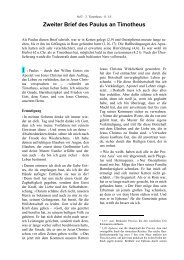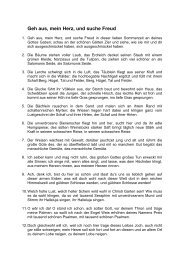Create successful ePaper yourself
Turn your PDF publications into a flip-book with our unique Google optimized e-Paper software.
It is obvious from even this small number of facts<br />
about ”biological computers“ that, next to the<br />
comparatively simple computers of our own<br />
technology, they are masterpieces of miniaturisation,<br />
complexity, and design perfection.<br />
All cells in our body carry the same information,<br />
regardless of their locality (e. g. kidney, liver, or<br />
arm). But different cell types access and process<br />
different sections of the available information. As<br />
in the case of physical computers, the original<br />
information is not transferred to the CPUs.<br />
Copies are made and transported. In a computer<br />
the read/write head is positioned at the beginning<br />
of an application program on the hard disk<br />
to copy it. But in a cell several reading heads<br />
begin at different locations to make copies<br />
simultaneously, so that the various pieces of<br />
information required for a certain type of cell are<br />
read from all the “hard disks” at the same time. A<br />
biological computer performs two kinds of “computations”:<br />
It provides the information for protein<br />
synthesis as described above, and it replicates<br />
itself by means of cell division.<br />
The Genome Project: Scientists from all over the<br />
world instigated an ambitious project, intended<br />
to run 15 years, to chart the human genetic code<br />
and decipher it letter by letter (this is known as<br />
sequencing). The Human Genome Organisation<br />
was founded for this purpose and boasts about<br />
1,000 members in 50 different countries. The<br />
project officially began on 1st October 1990. The<br />
effort required to determine the letter sequence<br />
of human DNA was originally estimated as being<br />
thousands of man-years. We have already got<br />
some idea of the enormous amount of information<br />
contained in the entire sequence. <strong>Our</strong> genes<br />
contain the complete human construction plan.<br />
There, in code, we find instructions about how<br />
our eyes, ears or heart and all the physiological<br />
details of our bodies are formed, as well as all<br />
our abilities.<br />
78<br />
By the end of the year 2000 there was already<br />
much media euphoria about the complete<br />
sequencing of the human genome (the entire<br />
genetic information of human beings). Headlines<br />
such as “Life’s blueprint deciphered”, and variations<br />
on the same theme, were abundant. Associated<br />
with this, we were given a picture of a<br />
brave new world, in which all would now be possible:<br />
synthetic genes against AIDS would be prophylactically<br />
inserted into bloodlines. Alzheimer’s<br />
patients would receive transplants of genetically<br />
manipulated brain cells; cancer cells would, following<br />
the introduction of new genetic material,<br />
simply consume themselves; and gene-vaccinated<br />
transplant <strong>organs</strong> would no longer be rejected<br />
by the recipients.<br />
Reports like this are extremely impressive but are<br />
unfortunately not quite true. What is the real<br />
status of the research? At the end of 2001, only<br />
90 % of the letters of the genome have been<br />
deciphered. The remaining 10 % has not yet been<br />
deciphered with the required accuracy. It was<br />
presumed that 100,000 genes were distributed<br />
among the 23 chromosomes. Now it is thought<br />
to be more in the region of 30,000 to 40,000.<br />
What have we gained if, as is hoped, we have the<br />
complete succession of ACGT letters for the<br />
human genome by 2003? Will we then possess<br />
the programme for life? Will we know how our<br />
creator coded our brains, for example? Not in the<br />
slightest! What we will have is comparable to the<br />
complete text of the Bible without commas and<br />
full stops, in a language which we do not understand.<br />
It is therefore like a book that no-one can<br />
interpret. The actual work of translating the text<br />
(the semantics) won’t even have begun. It is<br />
unclear whether we will ever be able to decipher<br />
the genome. The Egyptian hieroglyphics were<br />
finally decoded because the Rosetta stone was<br />
found with a text in Greek, demotic and hieroglyphics.<br />
After a long period of research, the<br />
hieroglyphics were finally deciphered on the<br />
basis of the Greek text. There is no such stone<br />
available to us for the human genome.<br />
However, there is one very important thing we do<br />
know: nowhere is the information so densely<br />
stored as in the DNA molecule. As information is<br />
a mental not a material quantity, we deduce that<br />
this information cannot have developed within<br />
the material. An intelligent creator has to be<br />
behind it.
















